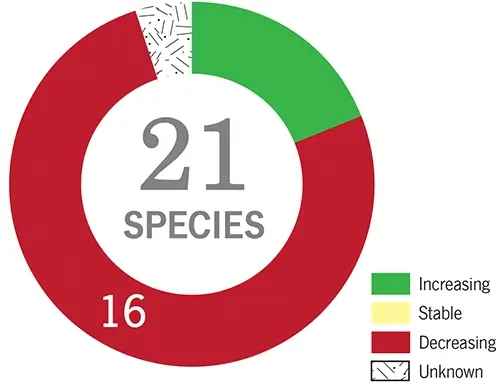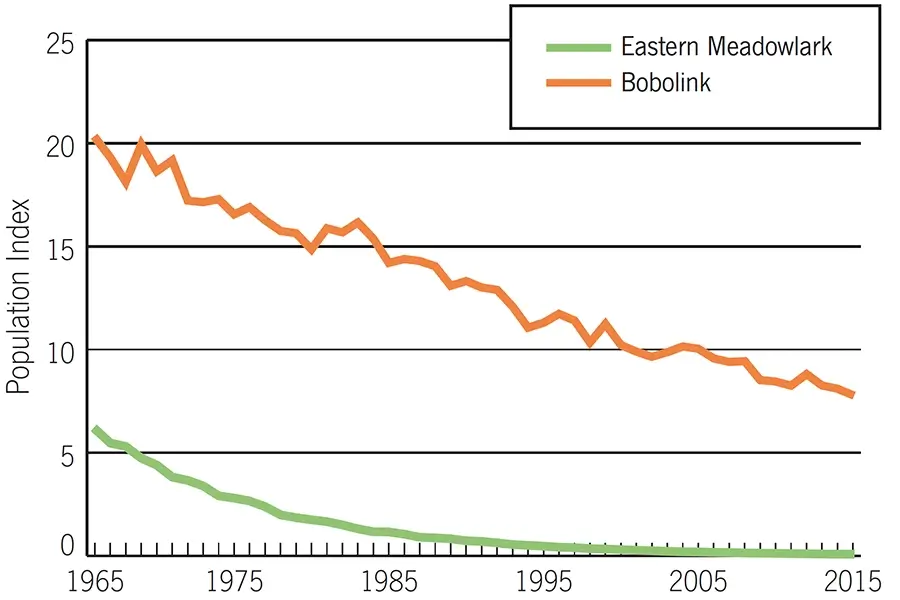Grasslands are typically large agricultural fields (pastures and hayfields), airfields, capped landfills, and reclaimed gravel pits. All grasslands in New Hampshire must be maintained by mowing, grazing, or burning to prevent their reverting to shrublands and, ultimately, to forests. The birds common to this habitat are more typical of extensive grasslands found in the Midwest and Great Plains. They may have colonized New England when forests were converted to farmland in the late 18th and 19th centuries, or – if already present in small numbers – become more abundant as grassland habitat expanded in New England. A few species are included in this category because open fields are their preferred foraging habitat, and as a result they nest in close proximity to grasslands but not actually among the grasses (e.g., American Kestrel, Cliff Swallow).

Upland Sandpiper
Northern Harrier
American Kestrel
Horned Lark
Cliff Swallow
Vesper Sparrow
Grasshopper Sparrow
Bobolink
Eastern Meadowlark
Tree Swallow
Savannah Sparrow
Red-winged Blackbird

Populations of most grassland birds are in decline. Only four appear to be increasing, and none of these are specialists in this habitat (e.g., Wild Turkey, Red-tailed Hawk, Eastern Bluebird ). Many once common species are now restricted to only a handful of nesting areas in the state (one site for Upland Sandpiper, two or three for Horned Lark).
Most declines among these birds can be attributed to habitat loss. Like shrublands, large grasslands were historically rare in northern New England prior to European settlement. As a result, most of the grassland birds that currently occur in New Hampshire are relatively recent colonists, and declines are clearly tied to the continued loss of this habitat to development, succession, or conversion to less suitable agricultural crops (e.g., corn). Of the grasslands that remain, many are too small to support area-sensitive species like Grasshopper Sparrow and Upland Sandpiper, which only nest in large fields and rarely use fields smaller than 30 acres.
Nests may be destroyed or young birds killed by equipment when fields are mowed too early in the season, before chicks have fledged. Early mowing also removes the grassy cover around nests, dramatically increasing nestlings’ exposure to predators.
Given the continued loss of New Hampshire’s grasslands, a key conservation strategy is to identify those grasslands that have the greatest potential to support large populations of multiple species. At such sites, typically large fields (greater than 30 acres), the focus should be a combination of land protection and appropriate management that benefits grassland birds. Even in smaller fields, delayed (after August 1) or partial mowing will benefit local populations of Bobolinks and Savannah Sparrows, and in the process may contribute to regional populations.
As grassland birds become more and more restricted to a smaller number of sites, it is important to monitor these sites periodically to make sure populations are still present. At sites where conservation measures such as delayed mowing have been implemented, we need concrete data on whether these actions have benefited the birds.
Many threats faced by birds are tied to the habitats where they breed. Explore the habitats and learn more about each one’s characteristics, population trends, threats, and conservation actions.
Contact Headquarters

National Wildlife Federation Affiliate
Website By CleverLight
Information for the species profiles on this website was compiled from a combination of the sources listed below.
The Birds of New Hampshire. By Allan R. Keith and Robert B. Fox. 2013. Memoirs of the Nuttall Ornithological club No. 19.
Atlas of the Breeding Birds of New Hampshire. Carol R. Foss, ed. 1994. Arcadia Publishing Company and Audubon Society of New Hampshire
Birds of the World. Various authors and dates. Cornell Laboratory of Ornithology.
Data from the Breeding Bird Survey
Data from the Christmas Bird Count